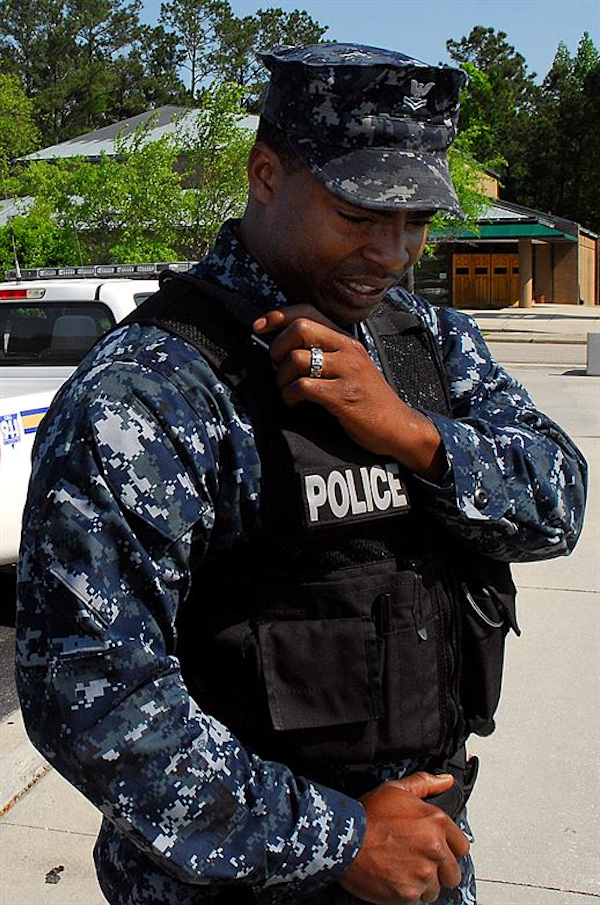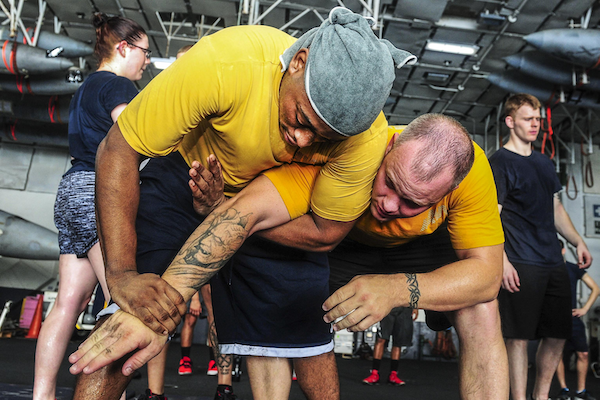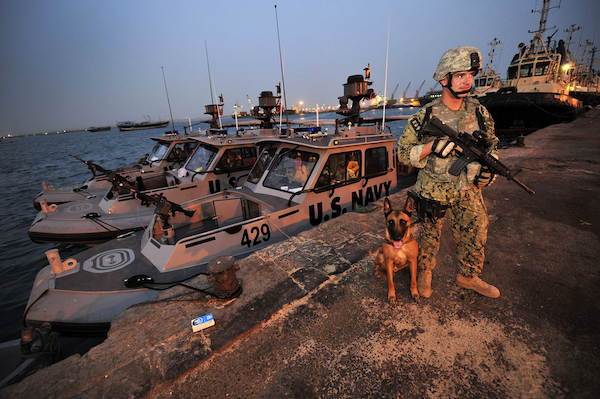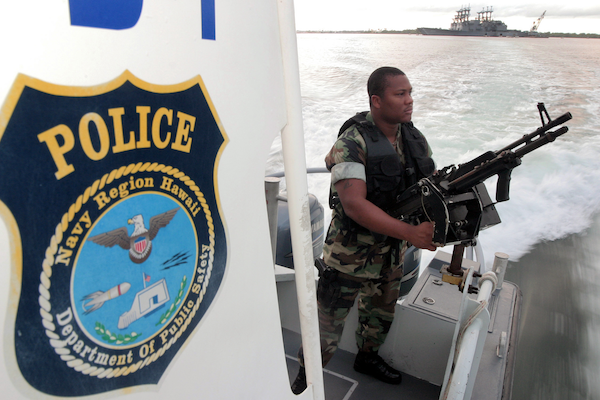A Navy Master-at-Arms is a Sailor trained as a security specialist.
They perform operations in the areas of law enforcement, force protection, physical security, and anti-terrorism.
Most people have heard of MPs, better known as Military Police, and the Navy equivalent to an MP is an MA.
Masters-at-Arms can find themselves filling pivotal security roles at land and sea commands all over the world.
Anywhere on the planet where there is a Navy asset, there is an MA there to protect it.
Trained in the latest, most effective law enforcement techniques available, the primary duty of the Navy Master-at-Arms is to protect and secure the Navy’s physical and personnel assets stationed around the globe.

Jump To A Section
Who Can Be a Master-at-Arms?
A Master-at-Arms has responsibilities ranging from uniform inspections to guarding nuclear warheads.
Because of the wide variety of duties, there may be specific qualifications for certain MA sub-specialties.
The following is a list of basic requirements for all Candidates for the Master-at-Arms rating:
- Must have a high school diploma or equivalent
- Must have a combined ASVAB line score of WK+AR+MK+MC>=196
- Must be a U.S. citizen and all immediate family members U.S. citizens or from low threat country
- Cannot have any Non-Judicial Punishment (NJP) or civilian convictions within three years prior to rating application
- Must have a valid state-issued driver’s license
- Must be eligible for a Secret security clearance
- Must have the ability to communicate fluently in the English language
- Cannot have a speech impediment
- Must have a negative result on a drug-screening test within 30 days previous to rating application
- No prescriptions for mental impairment or disorder within the last 36 months
- Must have vision correctable to 20/20
- Must have normal hearing
- Must have normal color perception
- Must be in a physical condition capable of sustained exertion and within official Navy body fat standards
- Must be capable of obtaining and maintaining a security clearance
- MUST be worldwide assignable
- Meet the Navy PRT test standards
As the Navy’s law enforcement officers, MAs must meet certain moral turpitude standards, similar to what other law enforcement agencies must meet.
These standards are not waivable, and will result in an application denial to the Master-at-Arms rating:
- Any drug-related conviction
- No history of drug use, marijuana excepted
- Repeated offenses involving alcohol
- Serious indebtedness
- Any criminal offense that is sexual in nature
- Domestic violence convictions
Related Article: Can You Join The Military With A DUI?

Master-at-Arms Training and Qualifications
The first step in your Master-at-Arms training will be attending Recruit Training, more commonly referred to as boot camp.
Navy Recruit Training takes place at Recruit Training Command Great Lakes in Great Lakes, Illinois. Here Recruit Division Commanders (RDCs) will teach you the basic military skills and knowledge necessary to begin work in the United States Navy.
While at RTC Great Lakes, you will also learn basic Navy ship handling, small arms usage, firefighting, and Naval heritage.
Barring any unforeseen circumstances, this training normally lasts about 7-9 weeks.
Once you graduate from Recruit Training, you will report to Joint Base San Antonio Lackland AFB in San Antonio, Texas, where you will attend Master-at-Arms Accession training, also known as MA “A” School.
While attending Navy A School at the Center for Security Forces (CENSECFOR), you will learn the skills to give you the basic knowledge necessary to perform your law enforcement duties.
By the time you graduate from MA A School, you will have received specialized training in:
- M9/M17 service pistol
- M14/M16 service rifle
- Mossberg 500 shotgun
- Expandable baton
- Oleoresin Capsicum (OC) spray
- Restraint devices
- Patrol vehicles
- Patrolling techniques and procedures
- Interview and interrogation techniques
- Report writing
- Use of force and rules of engagement
- Military law
After graduating from MA A School, you will officially be designated as a Navy Master-at-Arms, and you will receive orders to your first command.
Life as a Master-at-Arms
As a Master-at-Arms, you can receive orders to any Navy command in the world, and some commands outside the Navy as well.
This means you could receive orders to a variety of duty assignments and locations.
Because of this, I have broken down the different types of MA duty assignments and their daily duties.
Shore Based
A shore-based Master-at-Arms conducts law enforcement operations on Navy bases worldwide.
Here, you will conduct security patrols, investigate petty crimes, enforce base rules and regulations, and maintain good order and discipline among all military members and their families.
You will also be conducting security measures at all entry control points, verifying that only authorized personnel enter the facility, searching vehicles, and keeping watch for any suspicious activity.
Shipboard
A shipboard Masters-at-Arms are responsible for the security of the ship.
You will develop and implement shipboard security plans and ensure personnel are keeping the ship and its perimeter secure at all times during security watches.
You will be responsible for ensuring all security operations meet prescribed standards, and anti-terrorism measures are properly implemented.
You will also be responsible for conducting small investigations and assisting with major ones, maintaining good order and discipline among the crew, leading any detainee handling operations conducted on the ship, carrying out the Commanding Officer’s orders rendered at NJP, and managing the ship’s drug testing program.
Related Article – Dishonorable Discharge: Reasons, Consequences, and 3 Examples

Dog Handlers
Just as local law enforcement agencies have K9 Units, so too does the Navy. Masters-at-Arms assigned to be dog handlers will be stationed wherever they are most needed and can be reassigned at any time.
Dog handlers are charged with caring for and training Military Working Dogs (MWDs).
As a dog handler, you will conduct search and seizure operations with MWDs on Navy bases in a law enforcement role, or on deployment in a combat role.
MWDs require constant care and training, and dog handlers are entrusted with the responsibility.
Nuclear Security
Navy Nuclear Weapon Security specialists are stationed at submarine bases and nuclear weapons facilities around the world.
As the name suggests, in this role you will be protecting America’s nuclear assets by enforcing heightened security measures and carrying out all Presidential Orders regarding nuclear weapons facilities.
Corrections
Corrections Specialists are specially trained Masters-at-Arms that are stationed at Navy brigs.
At a brig, you will be guarding and caring for Navy prisoners, as well as maintaining positive control of all prisoners during any type of transport or movement.
Investigators
Investigators serve as the front-line criminal investigators at Navy commands.
As an investigator, you will conduct criminal investigations individually, as well as in conjunction with other investigating agencies.
Expeditionary Security
Expeditionary Security Force Specialists develop and implement security measures for deploying units, such as entry control points and perimeter security.
You will provide security for military assets during high-risk transits. You will conduct waterborne vessel screening and security, combat patrols, and Visit, Board, Search, and Seizures (VBSS).
You will be participating in tactical patrols, providing maritime security in ports, as well as for Embarked Security Teams (ESTs) onboard Military Sealift Command (MSC) vessels, and other high-value merchant ships.
Expeditionary security MAs conduct patrols, inspections, searches, and defensive measures for personnel and physical assets.
You will also be performing surveillance detection to identify any covert surveillance being conducted on Navy assets, as well as properly receiving and releasing detainees and prisoners during movements while incarcerated.
Sea/Shore Rotation
In the Navy, you will swap between deployable “sea” duties and generally nondeployable “shore” duties.
There are situations where these rotations can change, but as a general rule, the Navy will do everything in its power to ensure all Sailors are able to meet their proper sea/shore rotations.
The sea-to-shore assignment rotation for Masters-at-Arms is as follows:
- First sea tour will be 36 months
- First shore tour will be 36 months
- Second sea tour will be 36 months
- Second shore tour will be 36 months
- Third sea tour will be 36 months
- Third shore tour will be 36 months
- Fourth sea tour will be 36 months
- Fourth shore tour will be 36 months
Pay and Compensation
Your pay is going to be based on a combination of your rank and time in service.
MAs will generally be somewhere around the pay grade of E-2 or E-3 with right at a year of service once they become rated.
This means your starting base yearly salary could be roughly $27,108 as an E-3 with fewer than two years and max out at $102,3128 as an E-9 with 30 years of service.
This, of course, does not include Basic Allowance for Housing (BAH), or Basic Allowance for Subsistence (BAS).
MAs will also receive Sea Pay while they are attached to a Navy ship.
This amount is based on your rank and the amount of time you have at sea.
The amount can range from $50 a month as an E-3 and below with less than a year at sea, to $750 a month as an E-9 with 13 or more years at sea.
Again, this does not factor in your BAH or BAS allowances.
BAH alone can range from $8,240 to $66,130 a year depending on your rank, marital status, and where you live.
Although it fluctuates semi-annually, Masters-at-Arms typically tend to have a lower advancement opportunity than the Navy average.
This means your advancement as a Master-at-Arms may be more competitive than other Navy ratings.
Civilian Opportunities
Masters-at-Arms receive many skills through their Navy training and experience.
Their experience as trusted security agents for the Navy gives them a unique position as someone who can prove their integrity and high standards through their occupational experience.
Related Article: 10 Best Jobs In The Navy For Civilian Life
The following are some of the post-Navy career opportunities Navy Masters-at-Arms can find themselves:
- Law enforcement officer
- Criminal investigator
- Naval Criminal Investigative Service (NCIS) agent
- Federal Bureau of Investigation (FBI) agent
- Security guard
- K9 officer
- Corrections officer
- Nuclear power plant security officer
- Government security contractor
Through the Navy Credentialing Opportunities On-Line (COOL) program, Master-at-Arms have the ability to earn credentials they can use in the civilian world. For free, they may earn the following certifications:
- Certified Corrections Manager (CCM)
- Certified Corrections Officer (CCO)
- Certified Corrections Supervisor (CCS)
- Certified Crime Scene Analyst (CCSA)
- Certified Crime Scene Investigator (CCSI)
- Certified Emergency Disaster Professional (CEDP)
- Certified Forensic Interviewer (CFI)
- Professional Certified Investigator (PCI)
Additionally, Masters-at-Arms can earn apprenticeship designations from the Department of Labor through the United States Military Apprenticeship Program (USMAP) as certified apprentices in the following fields:
- Patrolman
- Security Professional
On top of all that, there is Active Duty Tuition Assistance and the GI Bill.
Tuition Assistance will pay up to $250 a credit, for 18 credits a year, and a total of 120 credits over a lifetime.
The Post 9/11 GI Bill provides 36 months of tuition, an annual book stipend, and Basic Allowance for Housing.
Because of their professional training, Masters-at-Arms are awarded semester credit hours in the following areas:
- Criminal investigation
- Criminal law
- Report writing
- Human relations
- Applied psychology
- Corrections procedures
- Instructor training techniques

What’s It Like To Be A Master-at-Arms?
Master-at-Arms often work 12-hour shifts, but they still receive two or three days off a week while stationed at a Navy shore facility.
They receive a lot of formal classroom training, as well as in-depth on-the-job training.
All of this training and experience often sets them up for successful careers after the Navy, while enjoying their career in the Navy.
As a Master-at-Arms, you have the opportunity to be stationed most anywhere in the world.
Masters-at-Arms are expected to be stationed overseas at least once in their career, which means you can be stationed in Cuba, Spain, Greece, or any number of countries.
Many MAs opt for overseas duty with deployed combat units in support of the War on Terror.
Related Article: 5 Best Navy Combat Jobs
MAs have demanding, yet rewarding jobs that keep their workdays interesting, and every day is guaranteed to be different.
If you are interested in a career in law enforcement at any level, becoming a Navy Master-at-Arms is the perfect way to get your start!
- Navy Promotion Timeline for Enlisted & Officers - June 19, 2024
- Navy SEAL Training (BUD/S) - June 19, 2024
- Navy Aircraft Carrier Flight Deck Shirt Colors Explained - June 19, 2024
Originally posted on June 19, 2019 @ 2:37 am
Affiliate Disclosure: This post may contain affiliate links. If you click and purchase, I may receive a small commission at no extra cost to you. I only recommend products I have personally vetted. Learn more.